Traveling with Grace: From Falun to Rättvik to Östersund
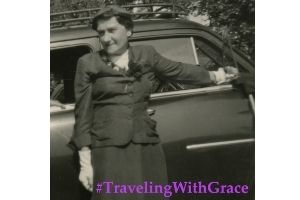
This week, Grace travels from Falum to Rättvik to Östersund and experiences the Swedish celebration of Midsommar. Special thanks go to JMM volunteer Harold Toppall for his transcriptions of Grace’s travel diary.
To read more of Grace’s travels, click here.
Date: June 21, 1950
Location: Falun to Rättvik, Sweden
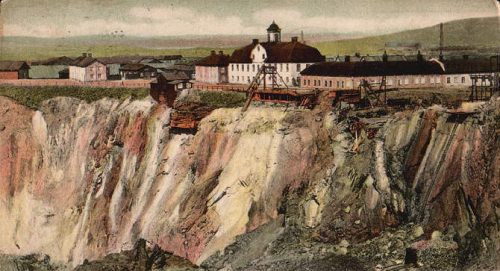
Left Falun at noon after visiting the old copper mine, largest in Sweden [and] in operation since 1600, & the old museum where we saw models of the mine at various periods which worked electrically with push buttons, also very interesting exhibits of wood in all its various usages. Stopped at Lekvand for lunch in a modest little restaurant. But no matter how simple they are always very clean + made attractive by the lavish use of trained vines + flowers.
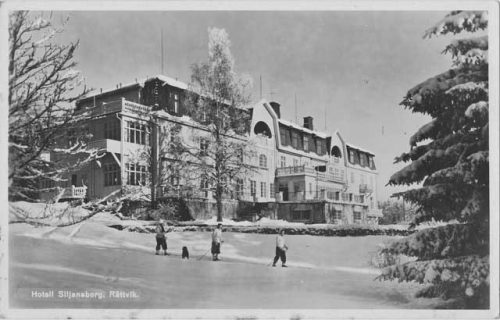
Arrived at Hotel Siljansborg at Rättvik on Lake Siljan about 3 o’clock. This is a charming resort on a very large lake (Siljan) surrounded by formal gardens & comfortably furnished, with a friendly home like atmosphere. We had a very warm welcome by English speaking hostess & later had tea on the verandah overlooking the beautiful garden with fountain below us & lake in the background, a charming setting. After dinner we played whist with Mr. Andersen & had fun.
Date: June 22, 1950
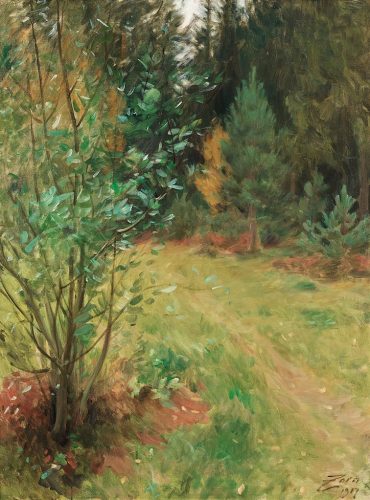
Met a Miss Arlene Hoffman from N. Y. & took her with us in the car to Mora, a pretty little town on Lake Siljan where we saw a statue of Gustav Vasa & went thru the attractive Anders Zorn museum where we saw many of his fine portraits, sketches, sculptures & beautiful nudes. Also landscapes of his native Dalecarlia. We left the museum in a drenching rain so came back to the hotel. Outside of a filling station we saw a man spraying his horse with D.D.T. to keep off the mosquitoes which are quite bad around here. At various places we have noticed May poles with decorations of the Star of David, but I have not found out why.
Tonight, we watched the dancing in the hotel. Some of the guests braved the wet lawns to pick flowers for tomorrow’s May pole (the word is a misnomer, it has nothing to do with the month of May but comes from an old Swedish work Mayo meaning flower festival).
Date: Midsummer’s Eve. June 23, 1950

This morning we rode over to Leksand which was in gay holiday attire, streets thronged with pleasure seekers, mostly natives many of whom wore the native costumes of Dalarna (Dalecarlia) a most interesting garb of fine hand work & many colors. The children, even babies, similarly clad. Street vendors doing a lively business in toys, balloons, dolls, souvenirs, a typical fair crowd the world over. A tent village had sprung up on the riverbank & food, hot & cold, sold at booths along the way. A circus was coming to town, in the usual red wagons. I noticed for the first time bright colored flower wreaths painted on wooden houses around windows & doors, reminiscent of Swiss chalets.
Back to Siljansburg for lunch. The meals here are delicious, the food varied. After lunch it is customary for the guests to help themselves to pastries & tea from the dessert table at the head of the dining room.
This afternoon we watched from the terrace the great ceremony of erecting the May Pole in the center of the lawn. First came 2 violinists (playing some traditional melody) dressed in black hats, long black frockcoats, chamois colored knee-pants, black hose topped with large red tassels. Following came a long procession of men women & children carrying the long pole twined in garlands of vines and flowers which they hoist by means of huge wooden scissors & when it is upright they fasten it to a tree stump with a heavy iron ring & this stays up until next year. On top is a Swedish flag surmounted by a cock & at either end of the cross arms hangs a round wreath like our Xmas wreaths with a heart shaped one in the center. The crowd danced around this holding hands & swinging first one way then the other while the two old fiddlers played for dare life. After about an hour the rain drove them inside where they continued their games & dances in the large parlor. The children had a party downstairs & the elders were served tea, coffee, fruit punch, cream cake, ginger snaps & sugar cookies in the lounge where a miniature May pole stood on the mantle shelf.
At 5:15 we went to the Gamalgorde for the raising of the big May pole of the townsfolk. The first person to greet me was Mrs. Aspman whom we met on the Gripsholm who was very glad to see us & introduced us to her daughter Marianne, a secretary at University of Stockholme. We had just got inside the park whey the procession came along: 2 dignitaries on horseback followed by eight fiddlers in the costume previously described, then 2 horse drawn carts filled with children & decorated with the boughs & flowers, then the villagers in their traditional garb. Thousands of people poured into the park, many in peasant costume, many others very well dressed indeed. They came here from all over Sweden as well as from abroad. The hostess from our hotel arranged for a chair for me, everyone else walked or stood. A man gave a long speech over the public address system (lost on us) & then everybody joined in singing the national song. The people are so friendly, smile & try to talk to us & let us examine their lovely costumes & exquisite old jewelry some of which look like heirlooms. They erected the May pole just like the other one at the hotel only this one is much higher & took longer to get in place. Then the dancing began & the caller sang the folk songs while the others joined in. I recognized some of the tunes & works we had heard this afternoon. The dances are very lively & the crowd performed with great spirit. It looks good to see the oldsters & youngsters join hands & hop around together.
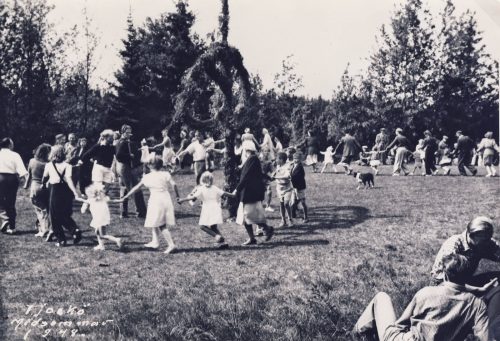
They danced, we hear, until far into the night but we went back to the hotel about 9 o’clock & there was more dancing with most of the ladies in pretty evening dress. It never gets really dark at night, sunset, twilight & sunrise following each other closely.
Date: June 24, 1950
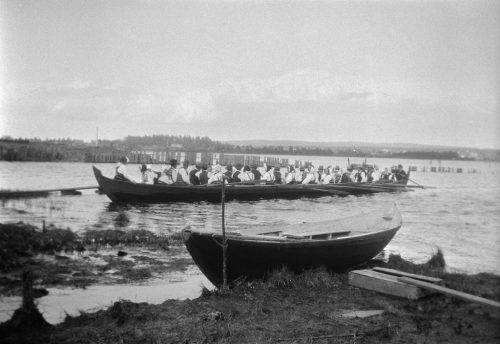
Today, Midsummer, they had services in the churches & the people went to Leksand to see the church boats (long narrow boats propelled by oars like Roman Galleys) filled with people in native dress come up the river to the church. The old church at Rättvik is also very interesting with log huts outside to accommodate horses in winter with cribs filled with hay.
This afternoon Mr. & Miss Aspman came to call and spent the afternoon with us. I ordered tea & they brought in a lovely assortment of cakes. We had a very pleasant chat & they stayed till dinner time.
Date: June 25, 1950
Location: En route to Östersund, Sweden
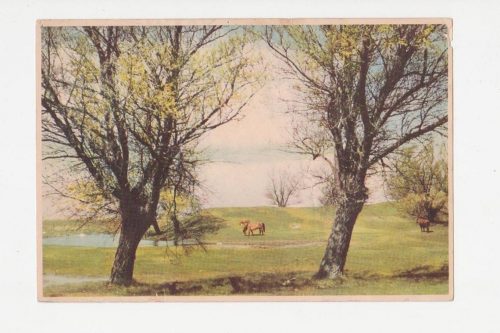
Left Siljansborg about 10 am in lovely weather & the ride was beautiful all the way. Saw some old folks on the road in peasant costume, evidently church ward bound, the usual cyclists manly of whom wave to us. Bicycles are often tied to the front of trolley cars. They are such friendly people. Am more & more impressed by the fine forests, lovely wild flowers which spread over the fields like thick oriental carpets, white [c………….] bells tinkling softly, the beautiful girls & children (I haven’t seen an ugly one yet.) The churches too are most interesting with their separate wooden belfries different in pattern in each district, and a flower bedecked church yard. We pass several picnic parties. They are wearing the briefest sun suits while we find our warm coats comfortable. We passed one turbulent stream with a lovely cascade & water churning over the rocks.
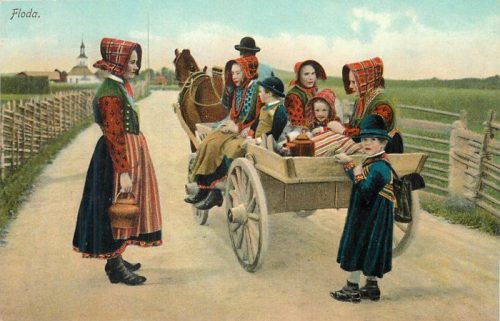
We stopped for lunch at a little hamlet, Hallefors Bruk, the restaurant most unprepossessing from the outside but very inviting inside (I had to go up about 8 steps). Every place is spotlessly clean here in Sweden & the inn keepers in the smallest places are so polite & neat in appearance. Here we had a delicious lunch with a new kind of bread I had never seen before & a sweet beer which was delicious.
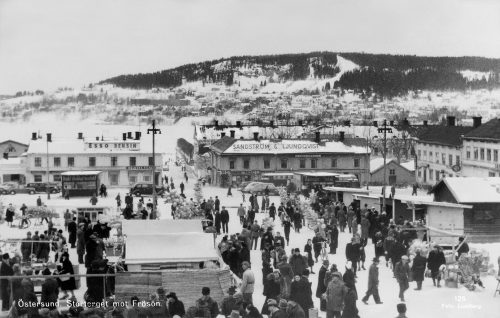
We are now going into the province of Jämtland. We arrived at Standard Hotel Östersund, a most beautiful town on Lake Storsjön about 5 pm. At dinner we met a gentleman from the Gripsholm who introduced us to his brother & as we were at adjoining tables, we talked during the meal which was very good.
In our room on arrival we found some women’s clothes in the cupboard & soon the owner came in to claim them, a nice young Swedish girl who was born here but lives in Stockholm. She came back to a wedding, speaks fairly good English & told us about the trip she just made to Italy and Switzerland.
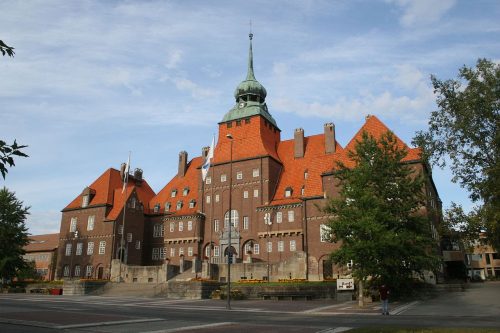
After dinner we took a beautiful ride around the lake which she had recommended. We saw the aviation field with some the air corps, saw a ferry which crossed the lake on a cable & transports passengers free of charge (Mr. Andersen says all ferries are free in Sweden, operated by the govt. of course.) On the way back we saw the highlights of Östersund,. Here we first noticed mts. flecked with snow. Everywhere are wonderful flowers. The City Hall, High School & Hospital of Epidemiology were among the most impressive buildings, a large stadium, & wide, tree-lined avenues. We saw the most gorgeous sunset within my memory.
Thanks for reading “Traveling with Grace,” a series where we’re sharing (and annotating) posts from the travel diaries of Grace Amelia Hecht, native Baltimorean, b. 1897 and d. 1955. As mentioned in my introductory post transcription errors sometimes occur and I’ve made my best guesses where possible, denoted by [brackets]. – Rachel Kassman, marketing manager
